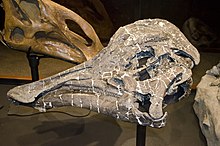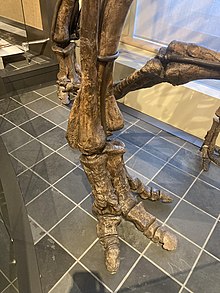Hypacrosaurus
| Hypacrosaurus | |
|---|---|

| |
| H. altispinus fossil at the Royal Tyrrell Museum
| |
| Scientific classification | |
| Domain: | Eukaryota |
| Kingdom: | Animalia |
| Phylum: | Chordata |
| Clade: | Dinosauria |
| Clade: | †Ornithischia |
| Clade: | †Ornithopoda |
| Family: | †Hadrosauridae |
| Subfamily: | †Lambeosaurinae |
| Tribe: | †Lambeosaurini |
| Genus: | †Hypacrosaurus Brown, 1913 |
| Type species | |
| †Hypacrosaurus altispinus Brown, 1913
| |
| Other species | |
| |
| Synonyms | |
| |
Hypacrosaurus (meaning "near the highest lizard" [Greek υπο-, hypo- = less + ακρος, akros, high], because it was almost but not quite as large as
Discovery and history

The
During this period, the remains of small hollow-crested duckbills were described as their own genera and species. The first of these that figure into the history of Hypacrosaurus was Cheneosaurus tolmanensis, based on a skull and assorted limb bones, vertebrae, and pelvic bones from the Horseshoe Canyon Formation.
Species

H. altispinus, the type species, is known from 5 to 10 articulated skulls with some associated skeletal remains, from juvenile to adult individuals found in the Horseshoe Canyon Formation. H. stebingeri is known from an unknown but substantial number of individuals, with an age range of embryos to adults.[9] The hypothesis that H. altispinus and H. stebingeri form a natural group excluding other known hadrosaur species may be incorrect, as noted in Suzuki et al.'s 2004 redescription of Nipponosaurus; their phylogenetic analysis found that Nipponosaurus was more closely related to H. altispinus than H. stebingeri was to H. altispinus.[11] This was rejected by Evans and Reisz (2007), though.[12]
The new species Hypacrosaurus stebingeri was named for a variety of remains, including hatchlings with associated eggs and nests, found near the top of the
Description

Hypacrosaurus is most easily distinguished from other hollow-crested duckbills (
Classification



Hypacrosaurus was a lambeosaurine
The following cladogram illustrating the relationships of Lambeosaurus and its close relatives was recovered in a 2022 phylogenetic analysis by Xing Hai and colleagues. Unlike other modern analyses, they found the genus Magnapaulia to be within Hypacrosaurus, indicating it could be a potential third species.[17]
| |||||||||||||||||||||||||||||||||||||||||||||||||||||||||||||||||||||||||||||||||||||||||||||||||||||||||||||||||||||||||||||||||||||
Paleobiology
As a
Crest functions
The hollow crest of Hypacrosaurus most likely had social functions, such as a visual signal allowing individuals to identify sex or species, and providing a resonating chamber for making noises.
Turbinates are thin bones or
Thermoregulation
Examining the oxygen-isotope ratio from the bones from different parts of an extinct animal's body should indicate which thermoregulation mode an animal used during its lifetime. An endothermic (warm-blooded) animal should maintain a very similar body temperature throughout its entire body (which is called homeothermy) and therefore there should be little variation in the oxygen-isotope ratio when measured in different bones. Alternatively, the oxygen-isotope ratio differs considerably when measured throughout the body of an organism with an ectothermic (cold-blooded) physiology.[20] Oxygen-isotope ratios calculated for Hypacrosaurus suggesting that the ratios varied little, indicating that Hypacrosaurus was a homeotherm, and likely was endothermic.[21] This is in contrast to the Ruben et al. (1996) finding that Hypacrosaurus was not warm-blooded, which was based on the absence of nasal turbinates (see Crest functions subsection, above).[citation needed]
Nests and growth

Hypacrosaurus stebingeri laid roughly spherical
Cells

In 2020,
Paleopathology
The discovery of tooth marks in the fibula of a Hypacrosaurus specimen inflicted by a bite from the teeth of a tyrannosaurid indicated that this, and other hadrosaurids were either preyed upon or scavenged by large theropod dinosaurs during the Late Cretaceous period.[citation needed]
Paleoecology
Taphonomy
The large, monospecific assemblage of Hypacrosaurus stebingeri in Montana was interpreted as a group of dinosaurs that was killed by a volcanic ashfall.[20] This assemblage is considered autochthonous, meaning that the remains are thought to have been buried on or near the same spot where the individuals died. The variety of ages in this group supports that this was a biocoenosis—an actual life assemblage of animals.[27] The cause of death in a volcanic ashfall is suffocation by the ash and by the gases released from volcanic eruptions. The preservation of this diverse group of dinosaurs provides researchers with a growth series, which is a sequence of growth stages from juvenile to adult.[citation needed]
Environment

H. altispinus shared the Horseshoe Canyon Formation with fellow hadrosaurids
The slightly older Two Medicine Formation, home to H. stebingeri, was also populated by another well-known nesting hadrosaur,
See also
References
- ^ hdl:2246/1416. Retrieved 2007-05-02.
- ISBN 978-0-253-34817-3.
- S2CID 85665879.
- ^ ISBN 0-89950-917-7.
- ^ a b Gilmore, Charles Whitney (1924). "On the genus Stephanosaurus, with a description of the type specimen of Lambeosaurus lambei, Parks". Canada Department of Mines Geological Survey Bulletin (Geological Series). 38 (43): 29–48.
- ^ Lambe, Lawrence M. (1917). "On Cheneosaurus tolmanensis, a new genus and species of trachodont dinosaur from the Edmonton Cretaceous of Alberta". The Ottawa Naturalist. 30 (10): 117–123.
- ^ Matthew, William Diller (1920). "Canadian dinosaurs". Natural History. 20 (5): 1–162.
- JSTOR 2412696.
- ^ ISBN 0-520-24209-2.
- ^ ISBN 0-521-56723-8.
- ^ S2CID 83841024.
- ^ S2CID 86070917.
- ^ a b c Lull, Richard Swann; Wright, Nelda E. (1942). Hadrosaurian Dinosaurs of North America. Geological Society of America Special Paper 40. Geological Society of America. pp. 206–208.
- ^ Weishampel, David B. (1981). "The nasal cavity of lambeosaurine hadrosaurids (Reptilia:Ornithischia): comparative anatomy and homologies". Journal of Paleontology. 55 (5): 1046–1057.
- S2CID 221666530.
- ^ Brett-Surman, Michael K. (1989). A revision of the Hadrosauridae (Reptilia:Ornithischia) and their evolution during the Campanian and Maastrichtian. Ph.D. dissertation. Washington, D.C.: Graduate School of Arts and Sciences of The George Washington University. pp. 1–272.
- S2CID 250463301.
- ^ Chinsamy, Anusuya; and Hillenius, Willem J. (2004). "Physiology of nonavian dinosaurs". The Dinosauria, 2nd. 643-659.
- S2CID 84693210.)
{{cite journal}}: CS1 maint: multiple names: authors list (link - ^ ISBN 1-4051-3413-5.
- ^ Barrick, R. E., Showers, W. J. and Fischer, A. G. 1996. Comparison of thermoregulation of four ornithischian dinosaurs and a varanid lizard from the Cretaceous Two Medicine Formation: Evidence from oxygen isotopes. Palaios 11: 295–305.
- (PDF) from the original on 2017-01-10. Retrieved 2017-01-04.
- .
- PMID 18682367.
- PMID 22558351.
- PMID 34692099.
- ^ Behrensmeyer, A. K. 1991. Terrestrial vertebrate accumulations. In Allison P. A. and Briggs D. E. G. (Eds), Taphonomy: Releasing the Data Locked in the Fossil Record. New York: Plenum Press.
- ^ ISBN 0-520-24209-2.
- ^ ISBN 0-691-05900-4.
- JSTOR 3514834.
